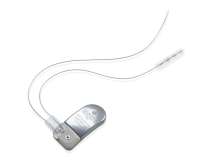Responsive Neurostimulation (RNS)

Brain-responsive neurostimulation with the RNS® System. Image Copyright 2017, NeuroPace, Inc.
At least 30% of people do not respond to seizure medicines. Some people can have surgery to remove where seizures start in the brain. This treatment is the only way to cure epilepsy, but it doesn’t work in everyone. On average, only about 60% of people can be free of disabling seizures from removal of a seizure focus in the temporal lobe. VNS Therapy or dietary therapies, such as the ketogenic diet, may help many people. Another option is responsive neurostimulation. Known as RNS® Therapy, this new seizure treatment was approved by the U.S. Food and Drug Administration (FDA) in 2013.
Everyone’s seizures are a bit different, either in type, number, or pattern. Therefore an ideal way to treat seizures is personalizing the treatment to each person. The ability to give the treatment only when it’s needed (at the time of a seizure or suspected seizure activity in the brain) is a key feature of the RNS® System.
The RNS® System is designed to work in 3 key ways:
- Monitor brain waves at the seizure focus, all the time - even during sleep.
- Detect unusual electrical activity that can lead to a seizure.
- Respond quickly (within milliseconds) to seizure activity by giving small bursts or pulses of stimulation. This goal is to help brainwaves return to normal, even before it could turn into a seizure.
What is the RNS®System?
The RNS® System is a smart device that is adjustable and reversible. Where it is placed and how it is used is tailored to each person. It learns what is going on in a person’s brain, and settings can be adjusted for each person.
Most comprehensive epilepsy centers that provide epilepsy surgery can also offer the RNS® System. Before having the RNS placed, a person must go though detailed testing to see where their seizures arise in the brain.

- The RNS® System is similar to a heart pacemaker. It can monitor brain waves, then respond to activity that is different from usual or that looks like a seizure.
- A device or stimulator is placed in the bone covering the brain. Tiny wires or leads are placed in one or two places on top of the brain where seizure activity may begin. These wires connect to the stimulator. Once the wires and device are placed, nothing can be seen.
- The system can give small pulses or bursts of stimulation to the brain when anything unusual is detected. This can stop seizure activity before the actual seizure begins. Or it could stop seizure activity from spreading from a small focal seizure to a generalized seizure.
- People cannot feel the stimulation once it’s programmed. It doesn’t cause pain or any unusual feelings.
- It’s not permanent. It can be turned off or removed if it doesn’t work or a person doesn’t wish to use it any longer.
Factsheet
Download this factsheet to learn about who can use RNS and how the device works.
Who Can Use The RNS® System?
- The RNS® System has been approved by the FDA to treat focal or partial seizures in adults, 18 years and older.
- It’s used in addition to seizure medictions. This is called adjunctive or add-on treatment.
- It’s designed for people with drug-resistant epilepsy. This means that a person continues to have seizures despite at least trials with two seizure medications.
- It’s used in people who can not have epilepsy surgery to remove where the seizures start or resective surgery has not worked.
How Does The RNS® System Work?
A device like the RNS® system changes or modulates brain activity to stop or prevent seizures.
The exact way that the RNS® System works is not known. It is thought to act on a certain substance in the brain called an inhibitory neurostramitter. This type of substance acts to inhibit or stop activity from brain cells that could lead to seizures. This may explain how the RNS works in the short term. Yet it’s long-term effect may be caused by something else affecting how brain cells work more broadly.
How Helpful Is RNS® Therapy?
Although the RNS® System is not a cure for epilepsy, it has shown to reduce seizures in most people who have used it. So far, these effects appear to improve over time in many people.
Real world retrospective study:
- 130 patients with the RNS® System were followed for an average of 2.3 years. The average decrease in seizures was 67% after 1 year, 75% at 2 years, and up to 82% after 3 or more years of using RNS.
- So far, about 3 out of 4 people with the RNS® System (77%) had their seizures cut in half after 2 years of using it.
- Some people had extended times of being seizure free as well. In the open label study or long-term study, 1 out of 3 people reported periods of no seizures for 6 months in a row.
Quality of Life Results
- Benefits of any therapy must also look at how a person feels and their quality of life.
- A study of 191 people with the RNS® System found improvements in quality of life aside from seizure control. These benefits did not appear due to changes in seizures or medicines. These included:
- Physical health
- Cogntitive functioning (for example thinking, remembering, and concentrating)
- Emotional health or mood
- Less worry about seizures
- Overall quality of life
Resources
The RNS® System is manufactured by NeuroPace, Inc. Additional information for patients and physicians is available at their website neuropace.com.
Resources
Epilepsy Centers
Epilepsy centers provide you with a team of specialists to help you diagnose your epilepsy and explore treatment options.
Epilepsy Medication
Find in-depth information on anti-seizure medications so you know what to ask your doctor.
Epilepsy and Seizures 24/7 Helpline
Call our Epilepsy and Seizures 24/7 Helpline and talk with an epilepsy information specialist or submit a question online.
Tools & Resources
Get information, tips, and more to help you manage your epilepsy.




